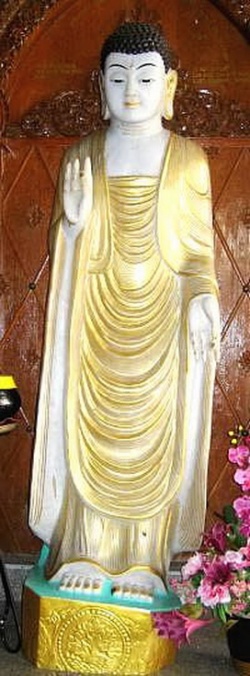Mahavihara
The Mahavihara (Pali for "Great Monastery") was an important monastery for Theravada Buddhism in Sri Lanka. It was founded by king Devanampiya Tissa (247–207 BCE) in his capital Anuradhapura. The Mahavihara was the place where the Mahavihara orthodoxy was established by monks such as Buddhaghosa. The monks living at the Mahavihara were referred to as Mahaviharavasins.
Etymology
The term Mahavihara was also applied to a number of the larger monasteries in India, among them Nalanda, Vikramashila, Odantipura, Somapura, Ratnagiri, and others. Theravada monastic groups Early history
Over much of the early history of Buddhism in Sri Lanka, three subdivisions of Theravāda existed in Sri Lanka, consisting of the monks of the Mahāvihāra, Abhayagiri Vihāra, and the Jetavana Vihāra. Mahāvihāra is the first tradition to be established, while Abhayagiri Vihāra and Jetavana Vihāra is established by monks who separated from Mahāvihāra tradition. According to A.K. Warder, the Indian Mahīśāsaka sect also established itself in Sri Lanka alongside the Theravāda, into which they were later absorbed. Northern regions of Sri Lanka also seem to have been ceded to sects from India at certain times.
According to the Mahavamsa, the Mahavihara was destroyed during sectarian conflicts with the Theravada monks of the Abhayagiri Vihara during the 4th century. These Mahayana monks incited King Mahasena to destruct the Mahavihara. As a result of this, a later king expelled the Mahayana monks from Sri Lanka .
The traditional Theravadin account provided by the Mahavamsa stands in contrast to the writings of the Chinese Buddhist monk Faxian (Ch. 法顯), who journeyed to India and Sri Lanka in the early 5th century (between 399 and 414 CE). He first entered Sri Lanka around 406 CE and began writing about his experiences in detail. He recorded that the Mahavihara was not only intact, but housed 3000 monks. He also provides an account of a cremation at Mahavihara that he personally attended, of a highly respected śramaṇa who attained the arhat stage. Faxian also recorded the concurrent existence of the Abhayagiri Vihara, and that this monastery housed 5000 monks. In the 7th century CE, Xuanzang also describes the concurrent existence of both monasteries in Sri Lanka. He refers to the monks of the Mahavihara as the "Hīnayāna Sthaviras" (Pali: Thera), and the monks of the Abhayagiri Vihara as the "Mahāyāna Sthaviras." Later history
Some scholars have held that the rulers of Sri Lanka ensured that Theravāda remained traditional, and that this characteristic contrasts with Indian Buddhism. However, before the 12th century CE, more rulers of Sri Lanka gave support and patronage to the Abhayagiri Theravādins, and travelers such as Faxian saw the Abhayagiri Theravādins as the main Buddhist tradition in Sri Lanka.
The trend of Abhayagiri Vihara being the dominant Theravāda sect changed in the 12th century CE, when the Mahāvihāra gained the political support of King Parakkamabāhu I (1153-1186 CE), and completely abolished the Abhayagiri and Jetavana Theravāda traditions.The Theravāda monks of these two traditions were then defrocked and given the choice of either returning to the laity permanently, or attempting re-ordination under the Mahāvihāra tradition as "novices" (sāmaṇera).
